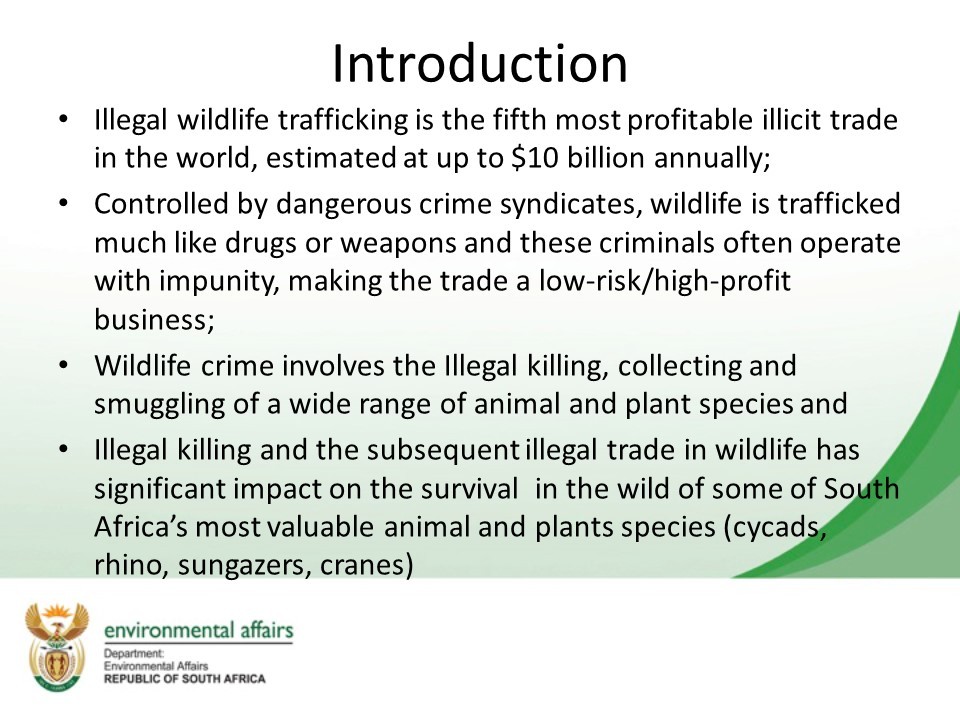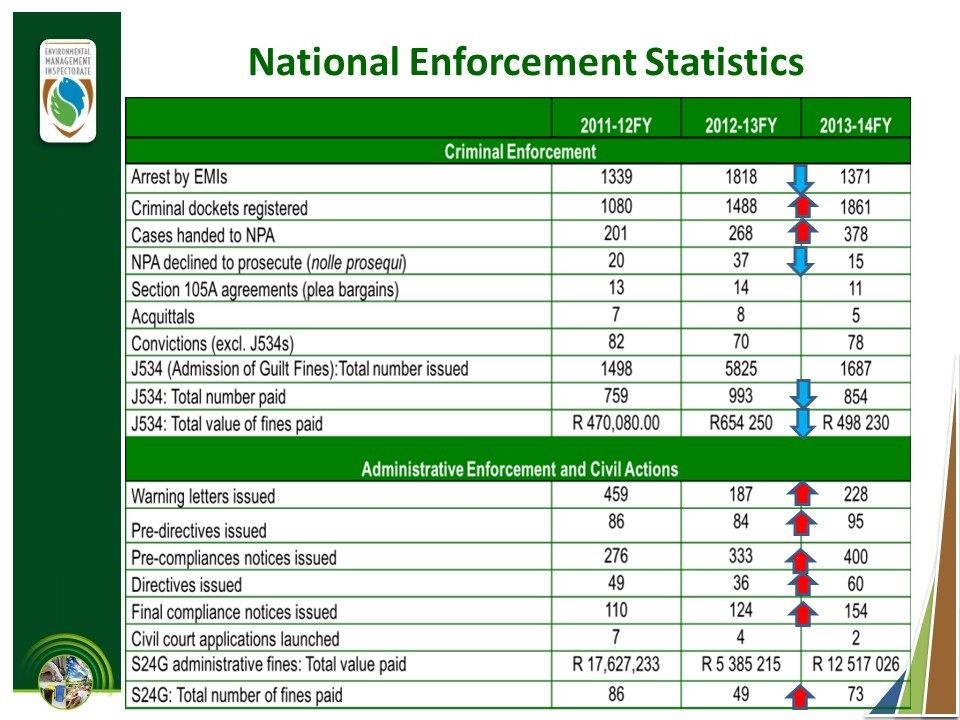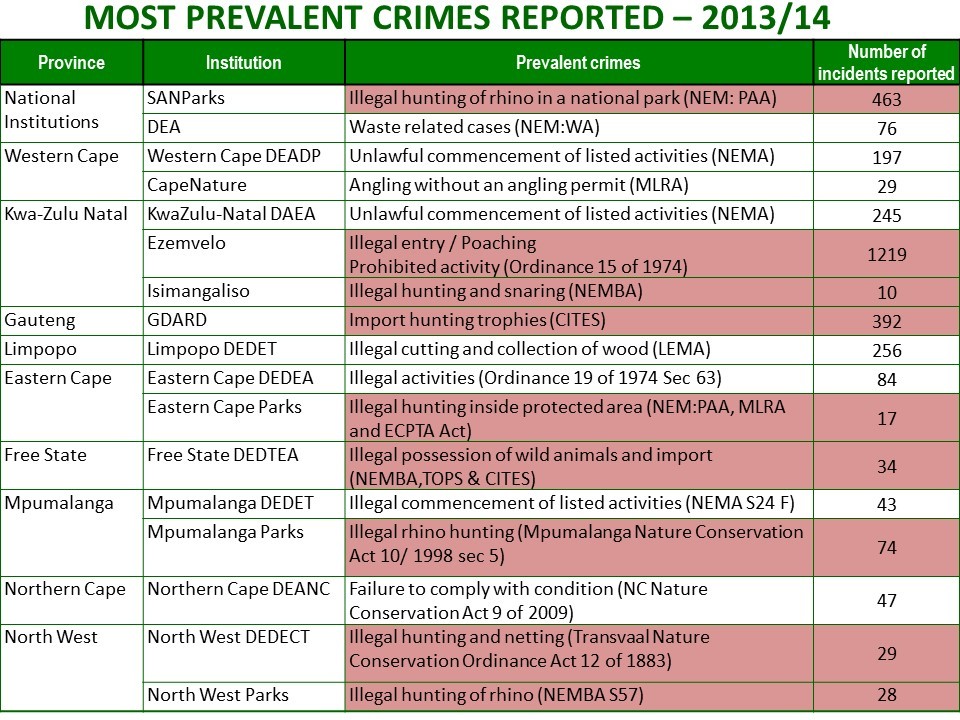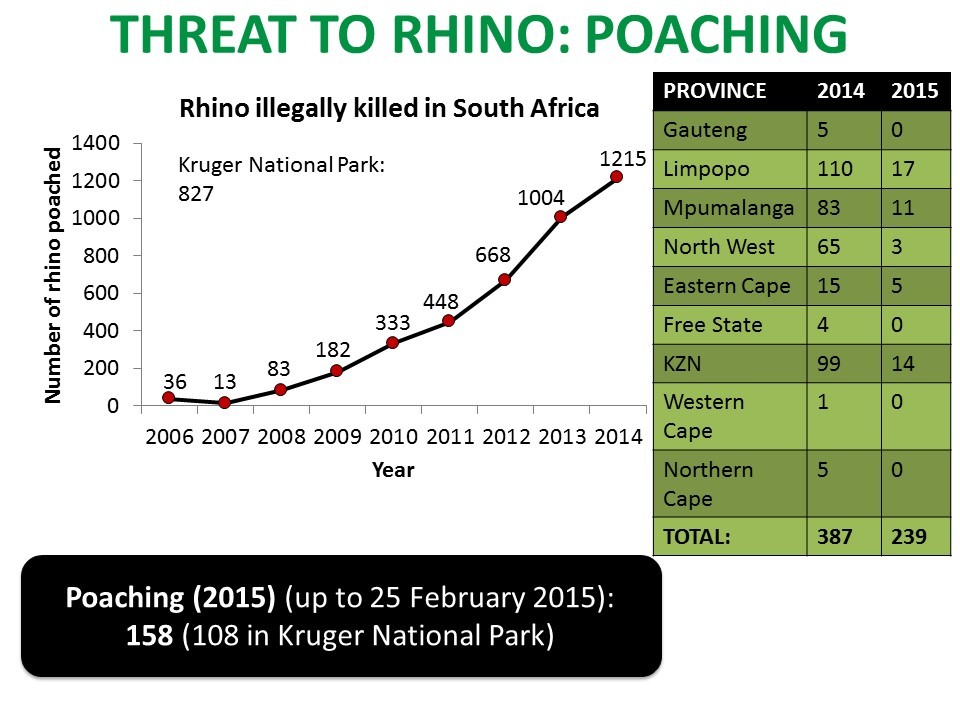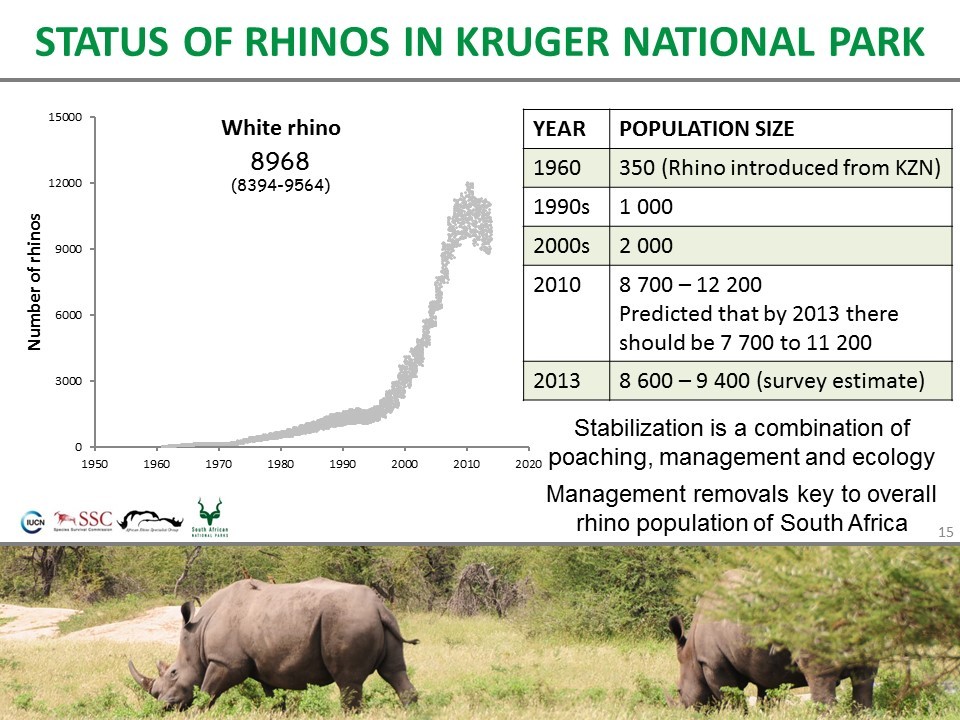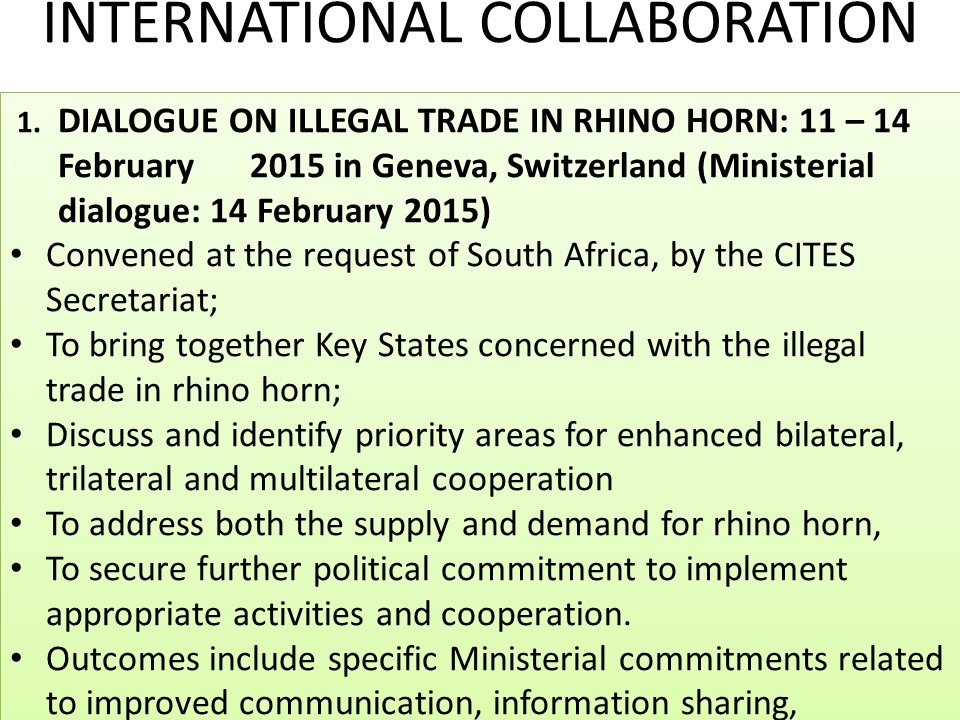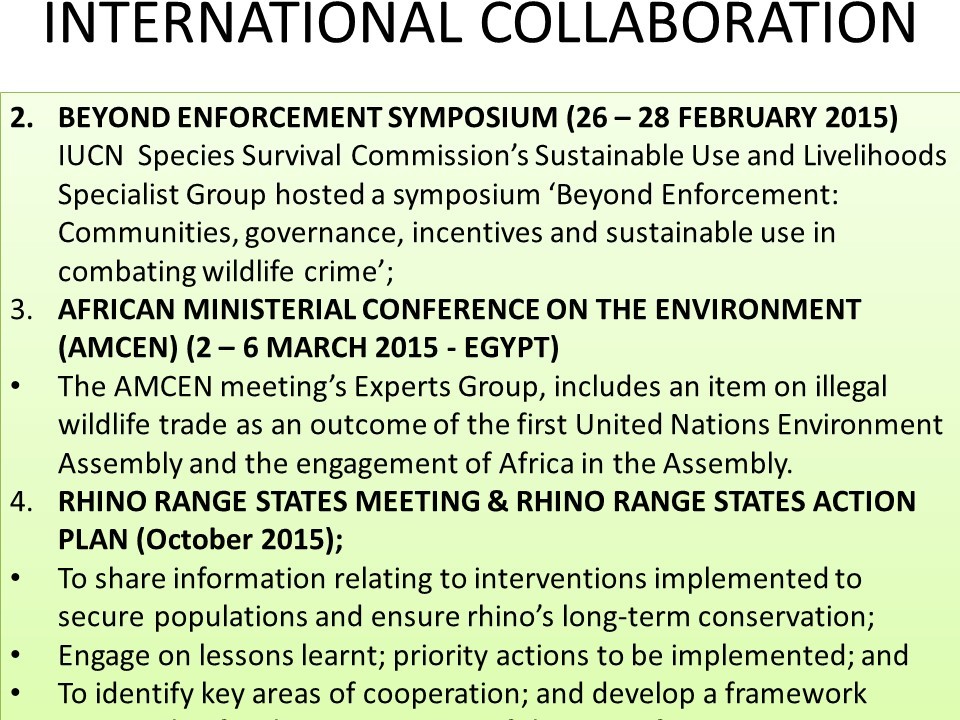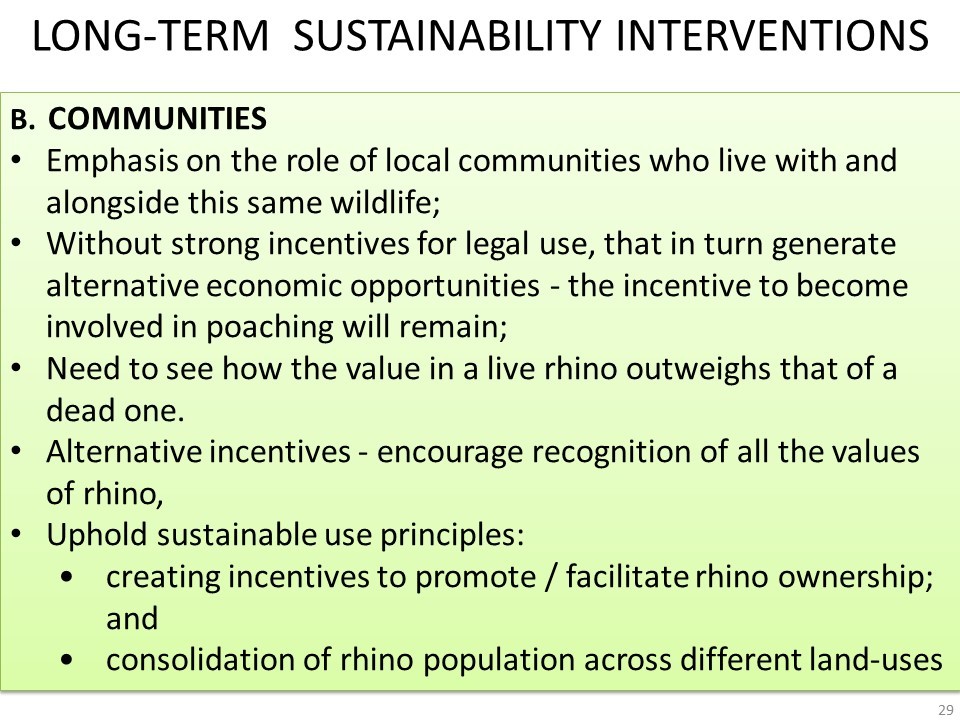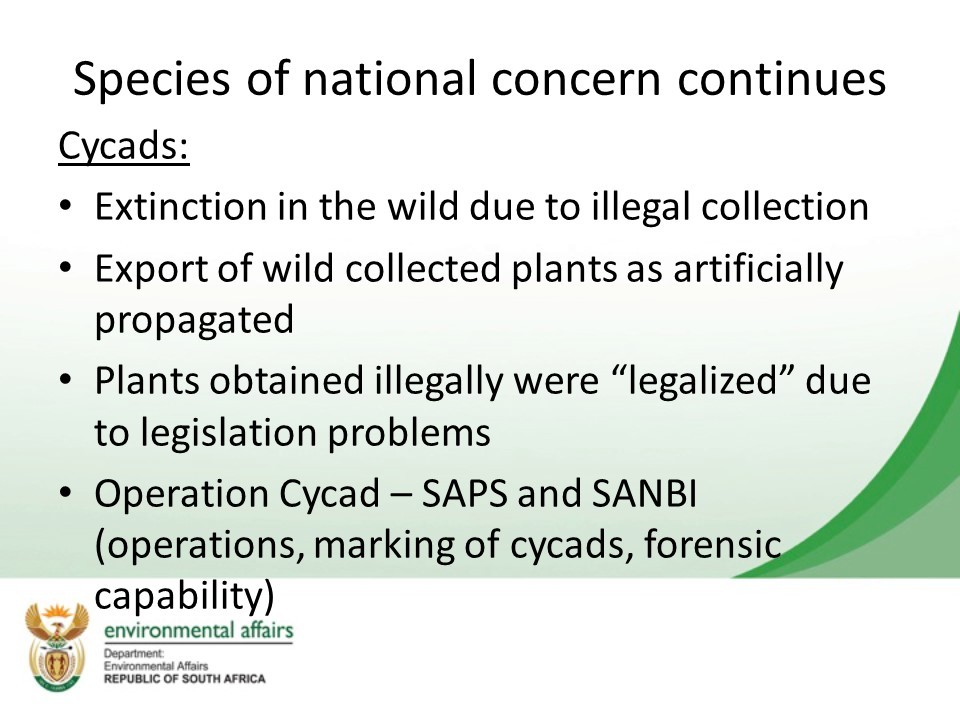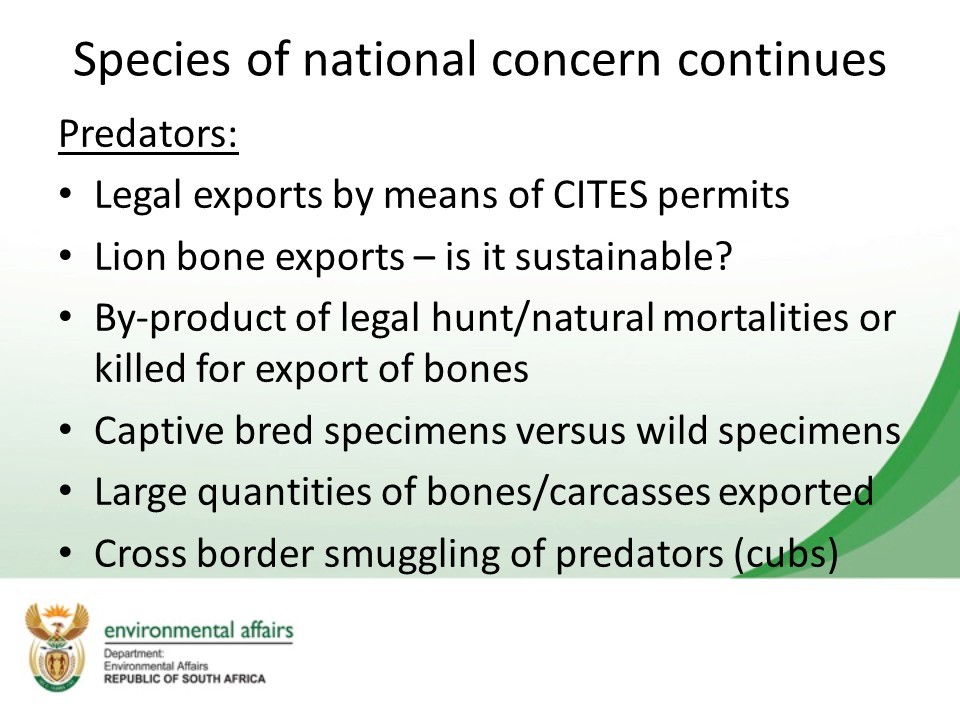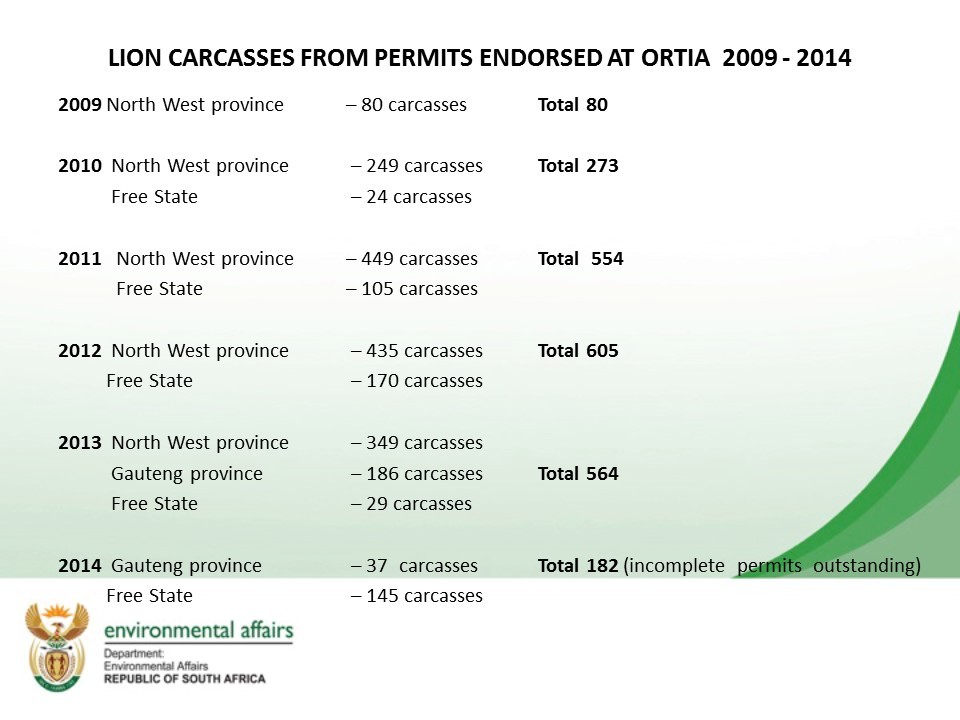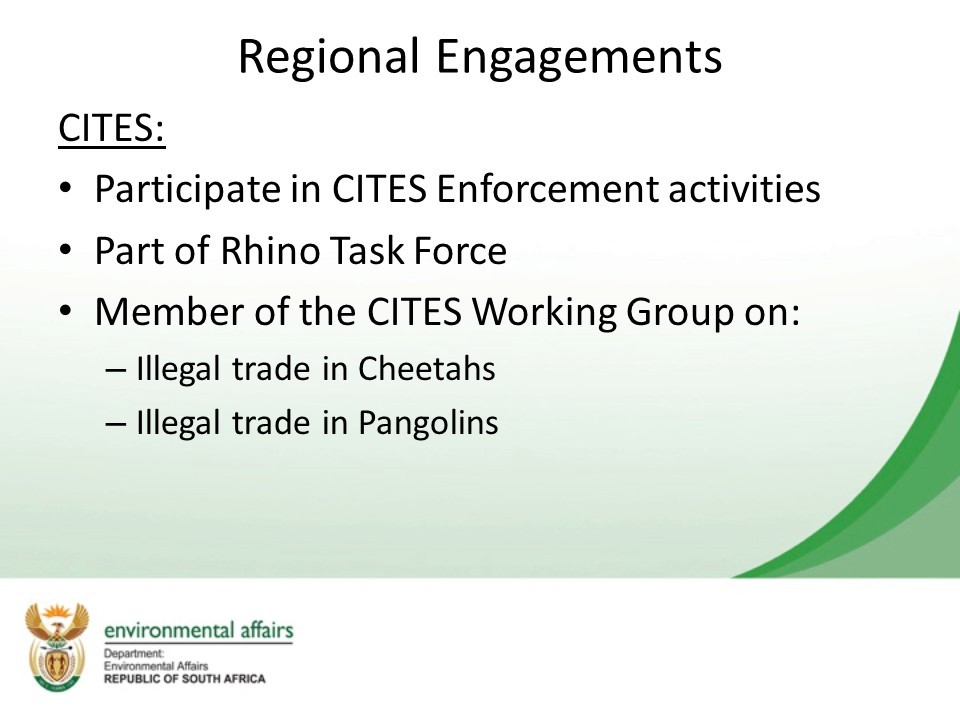https://pmg.org.za/committee-meeting/20100/
Summary
The Committee, in the presence of the Minister and Deputy Minister of the Department of Environmental Affairs (DEA) and senior officials of the Department wasbriefed on the state of wildlife crime in SA. The comprehensive presentation looked at the role of the Environmental Management Inspectors (EMIs), green scorpions and the Department in the space of enforcement, monitoring and compliance for wildlife crime. The briefing covered national capacity building programmes, international and regional engagements, challenges to be addressed before discussing species of national concern which included reptiles, birds, predators and cycads. Also included in the species of national concern were rhinos where the briefing specifically focused on integrated strategic management, managing rhino populations, compulsory interventions, national, regional and international collaborations, long term sustainability interventions and the committee of inquiry which was set-up to explore the possibility of legalising the possible trade of rhino horn or not.
The Committee then engaged in robust discussion with the Minister on the state of wildlife in SA questioning the capacity of the green scorpions, training to deal with the enforcement and prosecution issues of wildlife crime, the Department’s view on canned lion hunting and habitat loss. Many of the questions were particularly related to rhino and poaching issues where discussion was held on the details of the committee of inquiry – public funds spent on meetings and workshops and community involvement in the committee. Other points were asked around what private owners and the private sector was doing in terms of fighting poaching, success of the various international engagements especially in reducing demand management in consumer states, border security, translocation of rhino and transit routes for the movement of horn.
The Committee was then briefed on climate change matters the first which was a report from the UN Framework Convention on Climate Change (UNFCCC) on outcomes from the Congress of the Parties (COP) 20 held in Lima, Peru in 2014. The briefing began by explaining the competing architecture paradigms in the global negotiations (top-down Kyoto driven by science vs. bottom-up driven by a pledge and review system), looking back at COP17 in Durban (2011), key issues going into COP21 in Paris, France (2015), S’s expectations from the 2015 agreements, SA’s position going into COP2, key outcomes expected, political dynamics involved and SA’s preparatory process for COP21.
The second briefing explained the roadmap for finalising SA’s Intended Nationally Determined Contributions (INDCs) looking at the framework, adaption elements for the INDCs, mitigation elements of the INDCs and the technical work behind the consultation process.
Members then asked very pointed and relevant questions such as if the INDCs would be affected by the postponements for the air quality licences, the consultation process behind the INDCs and SA’s role as chair of the G77, particularly the vision behind the leadership of such a position. Other questions were around reducing the carbon footprint and reliance on coal of industries and government like with the construction of new power stations, new technology available for construction in this regard, the uptake of renewable energy and the need for the Committee to meet up with other Portfolio Committees on this discussion for commitments.
Minutes
Chairperson’s Introductory Comments
The Chairperson welcomed the Department and Deputy Minister of Environmental Affairs, Ms Barbra Thomson. The Minister and DG would be joining shortly. He highlighted the two items on the agenda, namely, wildlife crimes, looking not just at rhino but also discussing the committee of inquiry exploring the possibility of legalising the trade of rhino horn and climate change negotiations looking back at the Congress of the Parties (COP) 20 in Lima moving forward to COP21 in Paris, SA’s intended commitments and capacity. He said SA’s primary energy source was coal but this coal was causing a lot of headaches when it came to climate change. How would this be dealt with moving forward? Were there other sources of energy? How would dependency on coal as an energy source be reduced? Unless this was done there was no debate.
Committee Business
The Chairperson noted the Committee had a busy schedule this month and Members requested a further day to meet during the week. This day would be Fridays – no other days were available. This was for the month of March. Members should be prepared for this to deal with the mammoth task before the Committee.
Wildlife Crime
Ms Francis Craigie, DEA Chief Director: Enforcement, began the presentation by noting illegal wildlife trafficking was the fifth most profitable illicit trade in the world, estimated at up to $10 billion annually. The system was controlled by dangerous crime syndicates - wildlife was trafficked much like drugs or weapons and these criminals often operated with impunity, making the trade a low-risk/high-profit business. Wildlife crime involved the Illegal killing, collecting and smuggling of a wide range of animal and plant species and the subsequent illegal trade in wildlife had significant impact on the survival in the wild of some of South Africa’s most valuable animal and plants species (cycads, rhino, sungazers, and cranes). DEA had a mandate to enforce the National Environmental Management Act (NEMA) and Specific Environmental Management Acts (SEMA’s) – in the legislative framework there was applicability of the National Environmental Management Biodiversity Act (NEMBA), Norms and Standards (for Rhino and Elephant) and Biodiversity Management Plans (for White Rhino, Cycads, African Penguin).
The Environmental Management Inspectorate (EMI) Network of environmental enforcement officials across spheres of government, and across environmental media with standardised powers and training in terms of compliance monitoring and enforcement. The EMI network had a distinctive national identity with a national profile.
The Department was to co-ordinate through the Working Group Four, the SA Police Service (SAPS) and EMIs (who carried criminal dockets), nationally coordinate the Green Scorpions, conduct national training programmes, conduct compliance and enforcement joint operations, build partnerships and conduct environmental compliance and enforcement lekgotlas. DEA was also responsible for the national hotline on information collection and reporting, develop and facilitate the implementation of an environmental compliance and enforcement strategy and deal with international engagements participation, e.g., with the Convention On International Trade in Endangered Species (CITES) Rhino Enforcement Task Force / Interpol / Southern African Development Community (SADC) and other networks.
Ms Craigie then discussed the national capacity building programme noting the basic training was on the EMI which was a prerequisite. Following this was the EMI specialised training (which included training one the use of minimum force, an AIS bridging course and Biodiversity crime scene management), prosecutor training, magistrates awareness raising programme and external stakeholder training for customs (Illicit International Cross Border Movement Of Endangered Species Training) and incorporated training for SAPS.
Ms Craigie turned to look at species of national concern which were, namely,
1. Reptiles:
Traded mostly for pet trade and collectors
Extent of smuggling of indigenous species not known
Operation Cold Blood – national joint operation to ascertain compliance with provincial and national legislation
Easy to smuggle – did not need food and water for long periods
2. Birds:
Species looked alike which made identification difficult
Wild birds traded as captive bred - Indigenous seedeaters collected in the wild without permits
Concealment of eggs
3. Cycads:
Extinction in the wild due to illegal collection
Export of wild collected plants as artificially propagated
Plants obtained illegally were “legalized” due to legislation problems
Operation Cycad – SAPS and the SA Biodiversity Institute (SANBI) (operations, marking of cycads, forensic capability)
4. Predators:
Legal exports by means of CITES permits
Lion bone exports
By-product of legal hunt/natural mortalities or killed for export of bones
Large quantities of bones/carcasses exported
Cross border smuggling of predators (cubs)
Ms Craigie explained with international engagements, the Department collaborated with Interpol with SA being a Member of the Interpol Advisory Board of Environmental Compliance and Enforcement Committee. A number of operations were conducted and there were three working groups which led projects in specific areas. These groups included the Wildlife Crime Working Group, the Pollution Working Group and the Fisheries Working Group. It was in the Wildlife WG that rhino and elephant were focused on.
Regionally, there were engagements in CITES with the Department participating in CITES enforcement activities. The Department was also part of the Rhino Task Force and was a member of the CITES Working Groups on Illegal trade in Cheetahs and Illegal trade in Pangolins. Other regional interventions were with SADC on an anti-poaching strategy and through a Wildlife Enforcement Network of Southern Africa which established a network of national wildlife law enforcement agencies for the SADC region to operationalise existing international, continental, and regional wildlife protection commitments and initiatives and implement the relevant SADC protocols.
Challenges that needed to be addressed included sharing of information and use of meaningful intelligence to lead enforcement activities through a central database, the need for a national multi-discipline Task Force to fight wildlife crime, build and retain compliance and enforcement experience to fight wildlife crime, build an effective global network of compliance and enforcement officials to fight wildlife crime on a global scale and to enable growth and development while enforcing wildlife compliance.
Ms Craigie then addressed rhino issues specifically noting that SA was the key country in rhino conservation. In August 2014, Cabinet approved an Integrated Strategic Management approach that enhanced current interventions and introduced additional interventions. This approach included:
Managing Rhino Populations (interventions to increase numbers)
Compulsory Interventions
International and national collaboration and cooperation
Long-term sustainability measures
Ms Craigie discussed the managing of rhino populations stating the Rhino translocation programme was aimed at cost effectively protecting them and to create rhino strongholds in order to maximise rhino populations. Intensive Protection Zone (IPZ) had been created in the Kruger, where additional resources were being deployed in order to ensure better protection for the rhino population. 56 rhinos were moved out of poaching hotspots and trans-located from certain areas within the Kruger National Park (KNP) to an Intensive Protection Zone (IPZ) as well as to other more secure areas, in the last three months of 2014. Approximately 100 rhino had been translocated to neighbouring states during 2014, through both private partnerships and government initiatives.
With compulsory interventions there was a commendable effort to combat wildlife crime, however, it continued to be a growing problem worldwide with evidence of increased involvement of organized crime groups operating through well-developed criminal networks. A well-coordinated law enforcement response was also required to effectively combat transnational organized wildlife crime and it was critical to continue with and strengthen the compulsory interventions, primarily focusing on safety and security interventions that included new interventions and applying new methodologies as well as improve collaboration both at national and at international level.
National collaboration
International collaboration: MOUs
Long term sustainability interventions NB Committee of Inquiry and communities
In terms national collaboration, there was the Priority Committee on Wildlife Crime to ensure all provincial structures were co-ordinated, collaborated and functional in the fight against wildlife crime. Meetings were held for this committee in Mpumalanga, Kwazulu Natal, North West and the National Rhino Operational Centre in the Kruger National Park. Part of the committee included dedicated detective team in the Kruger National Park and continued engagement with the private rhino owners. There was also the Intelligence Working Group (IWG) on Illegal Wildlife Trafficking which was established through intervention of the Priority Committee on Wildlife Crimes of the National Joint Operational and Intelligence Structure (NATJOINTS). The committee was co-ordinated by the National Intelligence Coordination Committee (NICOC) to action the joint strategic interventions entailed in the National Rhino Strategy and in the Integrated Management Strategy approach. All affected departments were represented within the IWG. There was also the Transnational Crime and Corruption Center (Traccc) Project on conjunction with DEA, the Parks Foundation (PPF), the World Wide Fund (WWF) and the Security Cluster. Crack syndicate enterprises were monitored through the analyses of relevant information to detect and trace funds and monies used in rhino poaching activities.
Internationally, an MOU was signed with Vietnam in December 2012 and the implementation plan was signed 8 May 2013 and this implementation was on-going. The MOU between SA and the People’s Democratic Republic of Laos was awaiting signature. An MOU was finalised with the Kingdom of Cambodia to be signed on 8 April 2015 in SA. The MOU between SA and Mozambique was signed on 17 April 2014. A first draft of implementation had been developed and will be circulated to relevant authorities for comments. An MOU with the Peoples’ Republic of China (PRC) was signed in March 2013 but the implementation plan was still in negotiation. A dialogue on illegal trade in rhino horn was held between 11 – 14 February 2015 in Geneva, Switzerland convened at the request of South Africa, by the CITES Secretariat to bring together key states concerned with the illegal trade in rhino horn, discuss and identify priority areas for enhanced bilateral, trilateral and multilateral cooperation, to address both the supply and demand for rhino horn and to secure further political commitment to implement appropriate activities and cooperation. Outcomes included specific ministerial commitments related to improved communication, information sharing, enforcement and capacity building. Between 26 and 28 February the beyond enforcement symposium was held to deal with issues around communities, governance, incentives and sustainable se in combating wildlife crime. Between 2 and 6 March the African Ministerial Conference on the Environment (AMCEN) would be held in Egypt where there was an item on the agenda to discuss illegal wildlife trade as an outcome of the first UN Environmental Assembly and the engagement of Africa in the Assembly. In October 2015 there would be a rhino range states meeting and rhino range states action plan to share information relating to interventions implemented to secure populations and ensure the long term conservation of rhino. In the meeting there would be engagement on lessons learnt, priority action plans to be implemented and identification of key areas of cooperation and the development of a framework action plan for the conservation of rhino in Africa. The Rhino Protection Programme (Peace Parks) secured funding from the Dutch and Swedish Lottery to support different streams of interventions for technology like Unmanned Aerial Vehicles (UAVs), DNA analysis processes and to support information management mechanisms to assist in deployments and enforcement initiatives
Ms Craigie discussed the Committee of Inquiry noting that Cabinet authorised DEA to explore the possibility of legalising trade in rhino horn, or not. A 22 member committee was established. Preliminary screening was completed, but full security vetting on these members will commence soon. The inter-ministerial committee (IMC) consisted of the Ministers of Environmental Affairs, International Relations and Cooperation, Trade and Industry, Finance, Science and Technology, Agriculture Forestry and Fisheries (DAFF), Rural Development and Land Reform, Economic Development, Tourism, South African Police Services, State Security Agency and Justice and Correctional Services. The Committee of Inquiry will make recommendations to the Technical Advisory Committee, constituted of the Director-Generals of the Ministries on the IMC. A report containing recommendations, would be submitted to the Minister of Environmental Affairs, the Technical Advisory Committee and the Inter-Ministerial Committee by the end of September 2015.
The work streams of the committee of inquiry included:
Understanding socio-economic conditions and impacts of conservation areas on adjacent communities, as a means to support rhino conservation
A shift in Relationships: From stakeholder engagement to developing reciprocal partnerships between conservation agencies and communities to benefit rhino conservation
Addressing wildlife crime and disrupting criminal networks
Regulatory regime and controls
Impact of management decisions on the conservation of the species
Implications for other range States, transit- and consumer States
Supply and demand and potential models for trade
Trade partners (currently no work being done – to commence later)
The Sustainable use approach to wildlife management
The current South African rhino conservation status
Rhino history
Areas requiring research and information for the committee of inquiry included:
Socio-economic impact study and community stakeholder engagement.
Details relating to supply and demand, as well as trade mechanisms.
Demand reduction successes and key components of strategies that have succeeded.
A survey of private rhino owners to obtain more information relating to among others investment and disinvestment in live rhino, security costs, and interventions from private rhino owners.
The impact of poaching on tourism and the role of rhino and other endangered species (as well as the Big Five) in terms of Tourism.
Wildlife crime, including the disruption of national and transnational criminal networks involved.
Ms Craigie said the long-term sustainability interventions focused on communities and an emphasis on the role of local communities who lived with and alongside this same wildlife. Without strong incentives for legal use, that in turn generated alternative economic opportunities, the incentive to become involved in poaching will remain. There was a need to see how the value in a live rhino outweighed that of a dead one and for alternative incentives to be offered to encourage the recognition of all the values of rhino. Two land redistribution programmes for communities in Limpopo (Balepye and Selwane) were both undertaken as a project to utilise land for rhino conservation and sustainable game ranching. The ‘Beyond Enforcement’ Symposium, examined the role of community-based interventions in combating the illegal trade of wildlife, community development and awareness creation and to understand current survival mechanisms.
Discussion
The Chairperson welcomed the Minister and DG of the Department. The Committee received their apology for being late. He asked that the Minister of Deputy Minister speak to the details around the committee of inquiry – expectations, when work would be concluded etc.
Ms Edna Molewa, Minister of the Department of Environmental Affairs, after apologising for her late arrival from being in a management meeting, thought the presentation covered a lot of details around the integrated work as an approach to fight the scourge of rhino poaching. It was important to understand there was absolutely no intention to move away from the current initiative and plans implemented - if anything measures should be increased especially with technological interventions. For example, the Department was still researching drones with the Department of Transport but there were serious complexity in this space because sometimes drones were used for surveillance not always in line with the law. Although there were some pilots in this instance, the Department could not just go-ahead without a green light. Following from the Rhino Issue Management (RIM) process which consulted with almost all stakeholders in the country on this topical issue from which a range of recommendations were developed on the trade of rhino horn. She made it very clear the RIM report did not say that the rhino horns should be sold. From this cautious approach, Cabinet requested a variety of measures be explored including the possibility of some trade in rhino horn or not – this was just exploration and there was no position that government or the Department was moving towards legalising the trade in rhino horn. The investigation would inform which route to take on this issue especially looking at the literature, studying behavioural changes, impacts and looking at previous processes like the once-off sale of ivory. As such the Terms of Reference (TOR) of the inquiry was very vast even looking at community issues especially around ownership affecting demand reduction. TORs were given to a committee of inquiry. She highlighted the clause in the Public Finance Management Act (PFMA) spoke to the need for a committee of inquiry to be appointed by a minister while commissions of inquiry were only appointed by Presidents or Premiers. The committee consisted of more than just a panel of experts in order for the process to be as broad as possible. The committee had already had it first meeting. She noted there were enquiries from a few individuals that two members of the committee of inquiry were implicated in various issues. One of these individuals was the current head of the board of SANBI and another was a community representative and leader in the people and park programme. A pre-screening was carried out were many issues were looked at and nothing had come out from this pre-screening – the two members in question did not have criminal records. Full vetting would then take place and it was known that this process could take over a year.
The Chairperson requested the Committee be provided with the names of the members of the committee of inquiry as it was not in the presentation. He also wanted to full set of TORs for the said committee.
The Minister said the names of the committee were on the DEA website with the TORs.
The Minister indicated the names of the committee were on the DEA website along with the TORs but they would be printed for the Committee.
Deputy Minister Thomson added on the issue of community involvement noting the task was made difficult with SA having an economy which did not involve the bulk of the population. This economy needed to be transformed and this was one of the key long-term sustainability interventions. Communities needed to be convinced of the benefits of keeping a rhino compared to keeping a bull or cow for instance.
Mr S Makhubele (ANC) felt the Committee would still need to come back to the Committee in a reasonable time to follow up on the work carried out by the committee of inquiry. Looking at the green scorpions, he wanted to know if there was necessary capacity in all spheres of government. What caused the fluctuations of numbers? Were the training programmes referred to in the presentation were accredited? Who was carrying out this training? He also wanted to know what the private rhino owners were doing with rhino management – these owners should be helping and investing in strategies.
Minister Molewa said the Department would be happy to come back and an invitation would be extended again for the Committee to do a full visit of the KNP for Members to be exposed of the many activities taking place. This makes for better relation in terms of what the presentation was speaking about and to see the impacts of the programmes.
Mr T Bonhomme (ANC) was pleased with the information contained in the presentation regarding the committee of inquiry. He felt the team of the Department worked well. He was concerned reading about Zimbabwean President Robert Mugabe’s recent 91th birthday celebrations were elephants, lions and other wildlife were eaten and there was no opposition to this. King Zwelithini also held a function where a hippo was killed and eaten and nothing was said. People on the ground saw these high profile examples and would also think they could do the same. He asked if the licences for canning lions were still being made available and what was the Department’s take on this canning.
Minister Molewa, broadly speaking, said it was important to note there were different laws, sovereignty and operations in different countries. SA had the sustainable utilisation of natural resources with permitted hunting of certain species being within the law but she was not sure how it was dealt with in Zimbabwe. She could only comment on SA policy. With canned hunting, the Threatened or Protected Species (TOPS) regulations which were promulgated with NEMBA (2004) outlined prohibited actions for the hunting of lions which she read out to the Committee. Canned lion hunting was when these animals were hunted under the prohibited conditions i.e. canned lion hunting was clearly prohibited. She highlighted the Department stressed to the hunting industry, that when breeding a lion, when it was released into the wild where it could be hunted, that release must not happen before 24 months had passed i.e. do not hunt baby lion. When fighting this in court, the judgement was that DEA could not get involved in the business of determining the ages from when hunting could occur. This was the work of DAFF – she did not know how DAFF would get involved in parks and hunting but the courts needed to be obliged. DEA urged DAFF to have regulations on this matter in place as soon as possible to regulate the issue cooperatively in line with the court order. The regulations were currently being worked on.
Mr T Hadebe (DA) also thought the presentation was a good one. He was puzzled that little things, such as lion bones, were being taken advantage of and exploited – this painted a scary picture that a lot of work needed to be carried out. He asked the Committee be provided with the RIM report which the Minister made mention of.
Minister Molewa said this report would definitely be made available to Members but it was on the website.
Ms T Stander (DA) noticed the presentation did not make reference to elephant and abalone under threatened species. Habitat lost was of great concern for large mammals and knew the Department had plans for the amount of land to procure and the necessary budget, but how far was this process? Were successes seen from the numerous regional and international engagements? When would the implementation plan of the MOU with Mozambique be signed and did the plan provide for a hot pursuit clause? She wanted a copy of the MOU with Vietnam which was not made public. Was the Department involved in any demand reduction campaigns in any of the consumer states? Border security was a huge issue – was the Department getting enough support in this area from the responsible ministries? She read a police report which openly admitted that borders were porous especially with Mozambique. The Member heard the eastern boundary fence of the KNP would possibly be dropped and wanted to know what the status was with this matter. Were there any further plans to increase the capacity for training of magistrates and crime scene investigators etc because the area was still lacking despite the initiatives launched. What was the timeframe for the Department releasing official stats when two years ago they were released weekly? Was the Department 100% sure the stats were accurate and was there provision for pregnant rhino that lost calves while being poached? Intelligence was still poor despite work with Interpol, the Hawks and the police – how effective did the Department find the NATJOINTS? What was being done to increase actionable intelligence?
Minister Molewa explained SA did not have such a big problem with elephants but abalone was a big problem which was a special focus of the Department’s enforcement unit with fisheries control officers. It was also a resource in DAFF but there were cooperative efforts. Habitat lost was important in SA being the third most biodiverse country in the world after Brazil and Indonesia. This was where SANBI came in which kept data of all forna and flora along with new research for monitoring habitat lost. For now, not a lot of habitat was lost in terms of SANBI monitoring. It was probably too early to reflect on the real impact of all regional and international cooperation and commitments and also there were different stages or levels of cooperation between SA and different countries. With Vietnam both the MOU and implementation plan was signed a while ago so in this case cooperation was quite advanced. Vietnam was mobilizing people in terms of the rhino problem in SA but it was still too early to tell if the plan was bearing fruit. The Department was appreciative of the work the country was doing to speak to their own nationals against rhino poaching. The MOU with Mozambique was not signed yet because the country only inaugurated its president last month so there was a lot of election activity where meetings could be secured. Ministers were also only appointed after the President was but she would soon be meeting with her Mozambican counterpart. Nevertheless, this did not mean work between SA and Mozambique was not ongoing. The lowering of the Eastern Boundary in the KNP was lowered when Mandela was still President – this fence set up the Transfrontier Park or Peace Park. SA also had other transfrontier parks with Botswana, Namibia etc. There was a buffer agreement for management between the two countries but stronger enforcement was needed on this site. An operating centre was now fully set up after being launched at the end of last year and this was a very impressive programme using high-tech equipment working with intelligence services. Hot pursuit was not within the ambit of the Department but the SA Police Service (SAPS) did say they would engage in hot pursuit. DEA could not keep SAPS accountable for this because ministry could not hold another ministry accountable – this was the job of Committees. With stats, there was no hard written rule on when to release them. It would probably be released quarterly because it really took a lot of time for them to be compiled. It was more important for members to be released to fight the scourge against rhino poaching on the ground than crunch numbers all day. The Department would never shy away from releasing stats especially when improvements were seen but stats could not be the preoccupation. She was not sure if there was a law from when a pregnant rhino was considered pregnant as applied to human females. The Department did not only rely on NATJOINTS because there were many other programmes for working with SAPS and security forces.
Ms Nosipho Ngcaba, DEA DG, added with MOUs, these documents were not detailed because it was crafted in line with diplomatic relations. The implementation plans dealt with more detail while still being guided by aspects of diplomacy. A lot of work was being put into the legislative framework and regulations of Mozambique in collaboration with DEA after the Minister instructed the teams of both countries to begin this work.
Ms Craigie added that through the Interpol working group and CITES task teams, there was a going back to basics to look at how to share information on the ground between officials of different countries to ensure real-time information sharing. This was being done through secure processes and communication channels.
Mr K Morapela (EFF), who was new to the Committee, was still trying to keep up. He wanted to understand the meaning of translocation and how it could provide benefits. He appreciated the very detailed presentation but he was concerned that there appeared to be an emphasis on communities who lived with the wildlife in question instead of educating the general society so that everyone could help each other and work against illegal activities with wildlife.
Minister Molewa clarified that, many years ago in the ‘60s when SA had just about 60 rhinos, the Late Dr. Ian Player, started the translocation programme for rhinos from one area to the KNP which explained why there were rhino in the KNP today. This programme allowed the rhino population to grow in more suitable habitats than were they were. Intensive protection zones were created in the Park itself with heightened security measures to prevent easy poaching. Rhino were translocated to other parts of the country and communities (in Limpopo, where land was available) including 160 rhino to two neighbouring countries in the SADC region. Translocation allowed for the populations to grow
Mr P Mabilo (ANC) said there was no doubt wildlife crime was plundering the natural resources of the country and this had negative social and economic impacts. He was concerned about possible depletion of the Department’s resources because of the hard work being carried out by government officials with enforcement and the huge responsibility which accompanied this etc. Was the private sector assisting in broadening the fight against wildlife crime? Was there research undertaken to ensure there was a broader strategy around reduction of demand? He noted the market was always stated as being in the East but the European Union was also used for translocation in rhino horn and such. Was there a plan for rewards and incentives for people to come forward with information?
Minister Molewa felt it important to indicate that the private owners were doing a lot of their own work. For example, in KZN private owners were working with many authorities and the green scorpions and some successes had already been said. There was also operation Whisper to look at the movement of poached rhino horns between KZN and Gauteng. CITES awarded the team working on this. There were some private owners whose actions were not so straight with the law but majority of owners were in working with the Department including those close to the KNP. There was a lot of, and appreciated, contributions from the private sector by giving cars, trained dogs and technology etc. The Department was set to receive a second donated helicopter from one of the private sector individuals. With capacity, there could never be enough especially human resources because the problem being faced was so huge. It was important to note that work being done by DEA was of a specific nature and was complimented by work being done by other departments. The Department could work harder and smarter. The inspectorate was being reintroduced at OR Tambo International Airport as a port of entry with trained officials. DEA was also included in the border control unit. She was not sure of the role of the EU in rhino horn trade routes but it was important to focus on the countries where the highest number of horn were going to.
Mr Ishaam Abader, DEA DDG: Compliance, Inspections, Monitoring and Enforcement, added with the number of EMIs, additional capacity was needed but the Department was trying to build this capacity especially at the local government level but funding and human resources were an issue. A strategy was developed to deal with this limited capacity and the Department could present to the Committee on the EMI capacity. Significant improvement was seen from the training already carried out, for example, there an increase in the number of convictions. The general awareness had been raised amongst prosecutors, judges and magistrates. SA’s sentences for these times of crime were among the best in the world – in this way, SA was almost a leader in terms of harshness of sentences and the bar was almost set for other countries to follow.
Ms Craigie added the training would be increased for magistrates and prosecutors through funding made available through the UNEP/GEF rhino project. The project was also important for information sharing and intelligence. With the transit routes, Asia was where the rhino horn was being used but transit was seen through Africa and Europe for the horn to reach Asia. With rhino trophies, the horn was being taken back to Europe especially among Czechoslovakia, Slovakia and Poland. Transit countries were being mapped out through the Interpol channels.
Ms J Maluleke (ANC) sought clarity on community participation and how this voice was included in the committee of inquiry.
Minister Molewa said the TORs of the committee of inquiry included looking at the increased involvement of communities including community ownership of wildlife and benefit-sharing by communities. The communities would be engaged by the committee directly.
The Chairperson highlighted the meeting was work in progress and not exhaustive. The matters would again come before the Committee when the Department presented its Annual Report.
Ms Stander asked if any public funds were used for six meetings and one two-day workshops of the panel of experts held between December and January. Were there any discussions by any SA government official with any range state or CITES member state to discuss support for a proposal to CITES to lift the ban on rhino horn trade? Was the Minister or DEA aware of the current positions of each of the 180 CITES member states in terms of those who supported, did not support or did not decide on the stance regarding rhino horn trade? If the Department did not know, why was this so? There was discussion of a smart trade with syndicates to sell them the horns in order to stop poaching – as a policy principle, would DEA consider going into agreement with local or international syndicates in a trade off to stop poaching? As a policy principle, would DEA consider lifting the local moratorium in trade should international trade not be implemented?
Minister Molewa replied that there was still a moratorium on the trade of lose horn – there was no plan to lift this moratorium but the Department was being challenged on this in court. The Department would never deal with syndicates even for a discussion on smart trade – this would not be done. The Department did not ask the position on trade of the CITES countries because SA itself did not have a position yet. The work of the committee of inquiry was naturally compensated and this would be reflected in the Department’s Annual Report.
Ms Stander was confused because she had a written answer on the amount spent at each meeting of the panel of experts since January 2014. The answer outlined the committee of inquiry met 2 February 2015 with R32 000 spent on the meeting. But the answer did not cover the six meetings or the one two-day workshop. Why were these meetings and workshop not covered? She needed this answer.
Minister Molewa said this was a misunderstanding – the question was about the committee of inquiry and that was what the answer dealt with. If the question was about the panel of experts, the answer could be provided. There was nothing to hide.
Ms Ncgaba added the question asked about January 2015.
The Chairperson allowed the Minister to excuse herself at this point of the meeting. More detail would be given to Ms Stander’s question after it was now understood.





